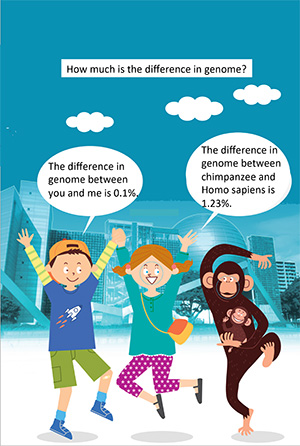Nagoya City Science Museum
TOP > Exhibition Guide > Floor Map> Wonder of Genome
Wonder of Genome

Purpose of Exhibition
The "Wonder of Genome" is on the Welcome Board at the entrance to Permanent Exhibit Room "Secrets of Life" on the 5th floor of the Life Science Building. It is an interactive game using a computer and sensors. Its aim is to stimulate interest in the commonality and diversity of life on Earth. Please pay attention also to the words that appear on the last screen of the game: "The Same with Different, Different with the Same, the World of Living Beings". That is the hidden concept of this floor. When you have finished the game, explore this floor thinking about the genome is.
The board on the opposite side from the game screen is a spot where you stick your head out from a hole and take a photo. Try it out.


Additional Knowledge
The entire genetic information that a certain organism requires in order to live is called its "Genome". Concretely, the DNA genetic material transmitted from parent to child is made up of four bases – A (adenine), T (thymine), C (cytosine), and G (guanine) and the genome is the information that tells the linear sequence of those four bases. Organisms on Earth all live and increase their descendants thanks to this mechanism of the genome. Differences between the base sequence in each genome create the diversity of life.
Currently, the entire base sequence of genomes is being read, primarily for human beings and for model organisms used in research. The number of bases that a certain organism has is called its genome size, which is expressed in units of base pairs (bp). Interestingly, higher organisms do not necessarily have larger genome sizes. For example, the human genome is about 3.3 billion base pairs, but the genome of the Easter lily plant has 50 billion base pairs. Also, the genome size and the number of genes are not proportional. Actually, in the base sequence of the genome, there are sections that functions as genes and sections whose functions are not understood.The complexity of organisms seems to not be decided by the genome size or the number of genes.
On the photo shooting board of commemorative photographs are drawn the differences between the genome of human boy and girl and that of a chimpanzee. The differences in genomes among children of the same human species (scientific name Homo sapiens) are 0.1%. This is the individual difference (also called variation) within the biological species called humans. Even though we have different sexes and blood types, it is a human being. However, the differences in the genomes of different species, humans and chimpanzees (Pan troglodytes) are called the "Species Difference or Species Diversity". The difference between the human and chimpanzee genomes is 1.23%.To put it the opposite way, the human and chimpanzee genomes have about 98% the same information.Aren’t you curious about what in the genes makes humans and chimpanzees different organisms? Comparing genomes , we can understand the branching of phylogenetic tree. of biological evolution into view.
Article by Chieko Ozaka,curator
